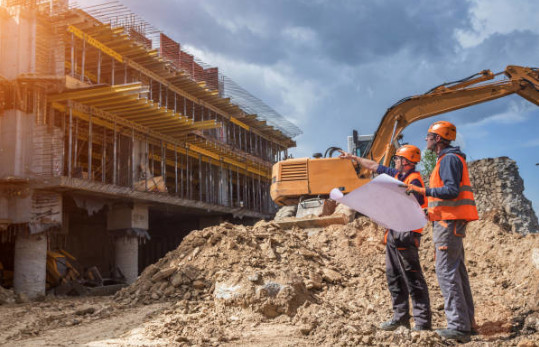Experienced Geotechnical Geologist for In-Depth Ground Investigations
Wiki Article
A Detailed Exam of the Services Provided by Consulting Engineers in the Field of Geotechnical Engineering: From Website Investigation to Job Implementation
Consulting designers in geotechnical design play a crucial role in the effective implementation of building jobs, starting with comprehensive website investigations that reveal crucial subsurface conditions. Their competence prolongs to soil residential property analyses, ecological influence analyses, and the mindful surveillance of project implementation, ensuring placement with safety and security and sustainability requirements.Importance of Geotechnical Design
Geotechnical design is an essential technique that underpins the safety and security and sustainability of civil facilities jobs. By understanding the mechanical behavior of dirt and rock products, geotechnical engineers assess the viability of websites for various constructions, consisting of buildings, bridges, and dams. This fundamental analysis guarantees that frameworks can stand up to environmental variables and tons without experiencing failure.The relevance of geotechnical design extends past simple structural safety; it additionally includes ecological stewardship. Appropriate geotechnical assessments add to reducing the eco-friendly influence of building. Through cautious evaluation of dirt buildings and groundwater conditions, designers can develop structures and keeping structures that minimize dangers such as disintegration and landslides, promoting lasting stability.
Additionally, geotechnical design plays an important duty in project expense monitoring. geotechnical works. By identifying possible issues early in the layout stage, engineers can suggest appropriate options, hence preventing pricey delays and redesigns throughout building and construction. This proactive technique not just enhances job performance yet additionally considerably decreases dangers related to unforeseen site problems
Site Investigation Strategies
Efficient site investigation methods are crucial for gathering accurate data regarding subsurface problems before building and construction. These techniques assist in the understanding of the geological and hydrological setting, which is essential for ensuring the stability and security of suggested structures.Typical approaches used in website examinations consist of borehole exploration, which permits designers to remove dirt examples at numerous depths, giving insights right into stratification and product types. On top of that, geophysical surveys, such as seismic refraction and electrical resistivity, offer non-invasive ways to analyze subsurface characteristics over bigger locations. These approaches can assist determine anomalies without substantial excavation.
Test pits are another useful method, supplying direct observation of dirt layers and enabling in-situ screening. geotechnical works. This strategy is especially helpful for shallow excavations and can help examine groundwater degrees. In addition, cone infiltration tests (CPT) are increasingly made use of, as they supply constant profiles of dirt resistance, which helps in determining dirt stamina and layering.
Each of these techniques plays an essential function in developing a thorough understanding of site problems, allowing consulting designers to make educated choices and recommendations throughout the task lifecycle. Precise information collection during the website investigation stage is critical to mitigating threats and guaranteeing successful task application.
Dirt Building Evaluation

The evaluation procedure usually includes a mix of research laboratory tests and area investigations. Key homes such as shear stamina, compressibility, permeability, and moisture material are examined to figure out the dirt's viability for building functions. Common examinations, consisting of the Atterberg limitations, Proctor compaction, and triaxial shear tests, are typically utilized to collect data on soil actions.
In enhancement to these tests, in-situ methods such as the Criterion Penetration Test (SPT) and Cone Infiltration Test (CPT) provide valuable understandings into soil stratigraphy and thickness. The outcomes of these assessments educate engineers concerning possible challenges, such as soil liquefaction or settlement, allowing them to develop suitable mitigation strategies.
Environmental Effect Assessment
Environmental influence examination plays a critical duty in the planning and execution of design projects, especially in geotechnical engineering. This process entails evaluating the potential ecological consequences of suggested jobs on soil, water, air top quality, and surrounding communities. Consulting designers use various techniques, including website evaluations, modeling, and area research studies, to identify and measure these impacts.The examination generally starts with the identification of standard environmental problems, which serves as a recommendation for predicting prospective changes. Engineers examine elements such as disintegration, groundwater contamination, and environment disruption, ensuring that all appropriate ecological policies and standards are abided by throughout the job lifecycle. Stakeholder involvement is also an important component of the examination procedure, as it fosters communication in between task developers, regional areas, and regulatory bodies.
Additionally, reduction approaches are created to address recognized influences, allowing engineers to suggest options or alterations to project designs that improve sustainability. This positive approach not only lessens damaging results on the environment but also promotes public count on and conformity with ecological regulations. Inevitably, reliable environmental impact evaluation strengthens the overall integrity and viability of geotechnical engineering projects, supporting responsible development practices.
Project Execution and Surveillance

Surveillance is a vital component of task implementation. Designers utilize different strategies, such as instrumentation and field tests, to analyze soil habits and architectural reactions in real-time. This continual monitoring allows the identification of any kind of deviations from anticipated efficiency, enabling timely treatments to mitigate dangers.
In addition, speaking with designers maintain open communication with service providers and stakeholders throughout the process. Regular site examinations and report card guarantee that all celebrations are educated concerning project condition and any type of emerging concerns. By fostering partnership and transparency, getting in touch with designers help with an extra efficient application procedure, therefore improving task results.
Ultimately, effective project application and tracking not just copyright safety and quality standards but also add to the overall success of geotechnical tasks, guaranteeing they fulfill their desired objectives sustainably and properly.

Final Thought
In verdict, the role of getting in touch with engineers in geotechnical design incorporates an important series of services that make sure task success. Ultimately, the diverse payments of consulting engineers are crucial in dealing with the intricacies of geotechnical obstacles in modern engineering jobs.Report this wiki page